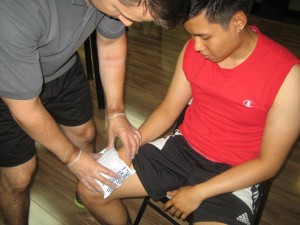After sustaining an acute injury, it is vital to utilize an ice pack to curb down the ensuing pain, inflammation and swelling. Various injuries such as strains and sprains necessitate the application of ice during the acute stage of injury. The RICE method is the ideal measure to control the inflammation to reduce the overall impact of any injury.
Steps in creating your own reusable ice pack
You can easily create a reusable ice pack at home. The items that you need for your ice pack include a plastic bag, rubbing alcohol (2-3 tablespoons) and several ice cubes.
- Store several ice cubes into a large-sized plastic bag. It is recommended to use a 1-gallon freezer bag.

Once an ice pack is applied on the injured area, it triggers vasoconstriction or closing down of the blood vessels. This diminishes the degree of swelling around the affected body part and also preserves motion in the late phases of tissue repair. - Place 2-3 tablespoons of rubbing alcohol into the bag. Seal the plastic bag and place it over the injured body part. Make sure that you will apply a clean towel or cloth around the plastic bag to prevent the body from becoming too cold.
- When storing the plastic bag in the freezer, the alcohol prevents the ice from turning into a hard block. In this manner, you can utilize the ice pack again.
It is important to note that the rubbing alcohol that was added into the plastic bag works by preventing the ice from completely freezing into a hard lump. An added advantage is that this reusable ice pack forms around any complicated body part during future use.
What are the benefits of using an ice pack after injuries?
After sustaining any type of injury, it is best to consult a doctor to ensure that the right treatment is given.
During a strain or sprain, the body transmits large amounts of fluid and blood to the injured region to clean it up and prepare for healing. During this period, the swelling disrupts movement and mobility around the tendons, joints or muscles.
Once an ice pack is applied on the injured area, it triggers vasoconstriction or closing down of the blood vessels. This diminishes the degree of swelling around the affected body part and also preserves motion in the late phases of tissue repair.
Applying an ice pack also reduces the pain after sustaining an acute injury. An ice pack should be applied every 30-45 minutes after an injury to improve the inflammatory response of the body. By using a reusable ice pack, this is possible.

